
improving fish passage and safety at Jordan's Point Dam on the Maury River involved removing the middle and retaining the edges
Source: City of Lexington, Project Description: Jordan's Point Dam Removal

improving fish passage and safety at Jordan's Point Dam on the Maury River involved removing the middle and retaining the edges
Source: City of Lexington, Project Description: Jordan's Point Dam Removal
John Jordan built a water-powered grist mill and sawmill at the confluence of the North River and Woods Creek, on what became Lexington's "Jordan's Point" in 1806. (A separate Jordan's Point already existed in Prince George County, named after Samuel Jordan who settled there in 1621. The Benjamin Harrison Memorial Bridge crosses the James River at the Jordan's Point near Hopewell.)
Waterpower at Lexington's Jordan Point was provided by a crib dam built across the North River. The dam was 180 feet long, built in four sections of wooden framework ("cribs") filled with stone. Apparently a wooden wall was built on the upstream side of the dam, with tan bark, clay and dirt used to pack the timber cribbing against leaks. The dam broke several times and required repairs, and regular maintenance included including adding more packing as well as replacing planks on the wall. The downstream side was reinforced later by adding a buttress covered in planks, preventing water that flowed over the dam from undercutting the cribs.
The waterpower enabled construction of a cotton factory in 1816. By 1840, a new dam of similar design was constructed at the same site, and the dam was replaced again one or two more times before 1911. A two-lane covered bridge was built above the dam in 1840 so wagons could cross the river more easily.

a covered bridge once crossed the Maury River above Jordan's Point Dam (red arrows)
Source: Virginia Department of Game and Inland Fisheries, Removal Report on Jordan's Point Concrete Dam and Timber Crib Dam: May 23-25, and May 28-30, 2019 (from W&L University Leyburn Library Special Collections)
In 1850, the North River Navigation Company bought Jordan's Point. A year later the company completed a canal that bypassed the dam, plus a diversion dam upstream to direct water into the canal. The mills were burned by Major General David Hunter in 1864 when the Union Army also burned the Virginia Military Institute, but the dam across the North River remained intact. The Richmond and Allegheny Railroad completed its Lexington branch and crossed the river at Jordan's Point in 1881, without altering the crib dam.
A 10-foot high, 180-foot long concrete dam was built just downstream of the site of the wood-and-stone crib dam in 1911, because the new rollers at the Lexington Roller Mills needed more waterpower. Though documentation is lacking, it appears the 32-foot long fishway on the north bank also was built in 1911.
The last of the industrial facilities at Jordan's Point were abandoned after a major flood in 1936.
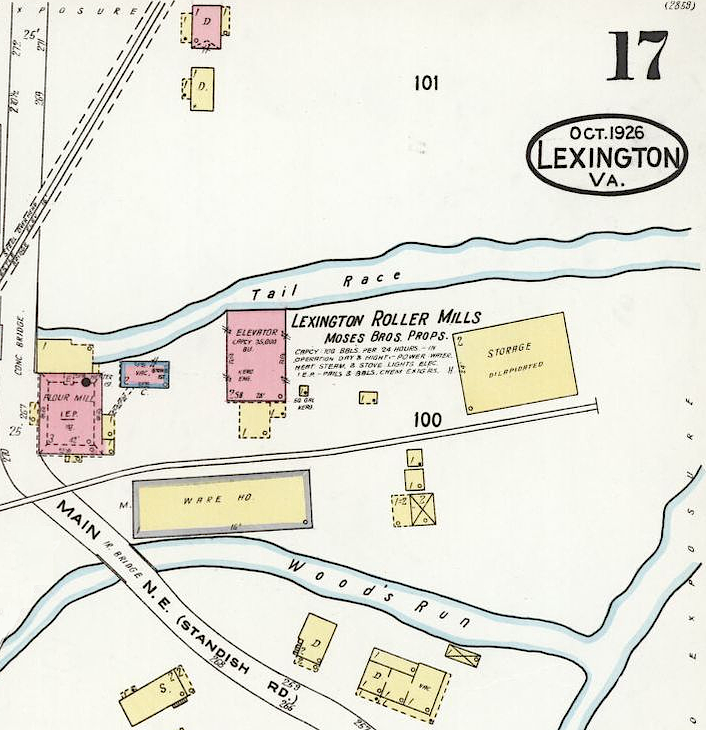
the concrete dam was constructed in 1911 to supply waterpower to the Lexington Roller Mills
Source: Library of Congress, Sanborn Fire Insurance Map from Lexington, Independent Cities, Virginia (1926)
The North River was renamed the Maury River in 1945. The wooden railroad trestle across the Maury River was destroyed during flooding from Hurricane Camille in 1969, but the concrete dam survived both the 1936 and the 1969 floods.1
Ever since 2006, when a teenager drowned at Jordan's Point Dam, the City of Lexington sought to remove the 10-high dam across the Maury River. Safety was more important to the city than fish passage, and economics played a role. The city had paid $100,000 to the estate of the 16-year-old who had been trapped in the hydraulic churn below the dam, and estimated repair costs were substantially higher than removal costs.2
The Virginia Department of Environmental Quality determined the dam had structural deficiencies (including a crack along the entire length) and was unsafe without repair. The $3 million cost to grout voids, encase the downstream face of the dam in concrete, pour a new reinforced concrete cap, and install anchors into the riverbed was equivalent to a year's worth of funding in the capital budget for the City of Lexington, but the US Fish and Wildlife Service and others were willing to provide the $190,000 needed for dam removal. That would increase the ability of fish and mussels to access the habitat upstream.
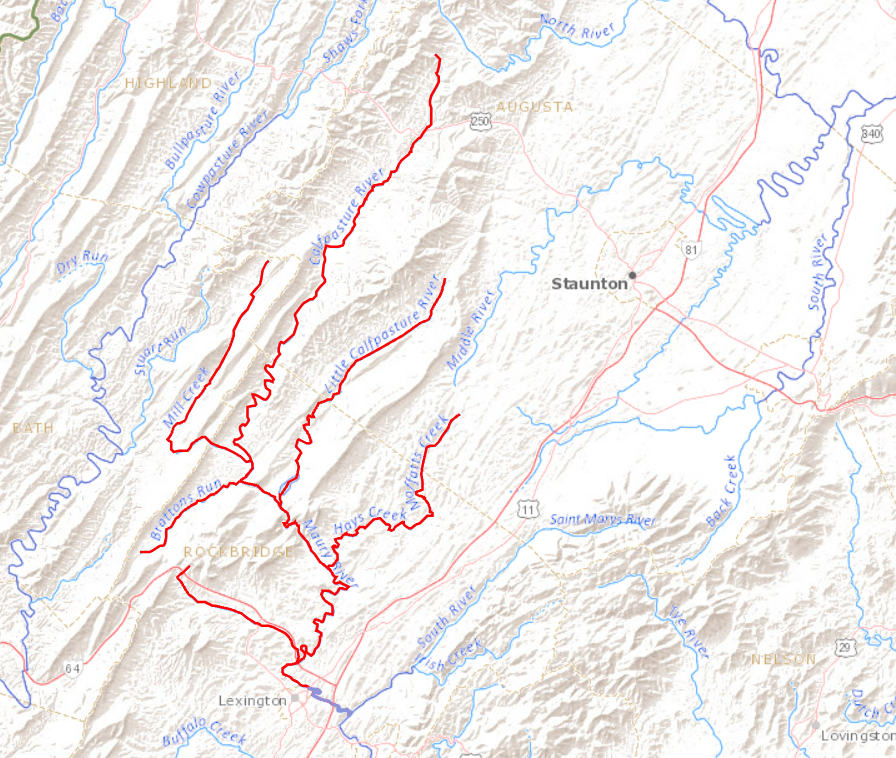
the US Fish and Wildlife Service was willing to fund removal of Jordan's Point Dam on the Maury River to improve fish passage to habitat upstream (red lines)
Source: US Geological Survey, Streamer
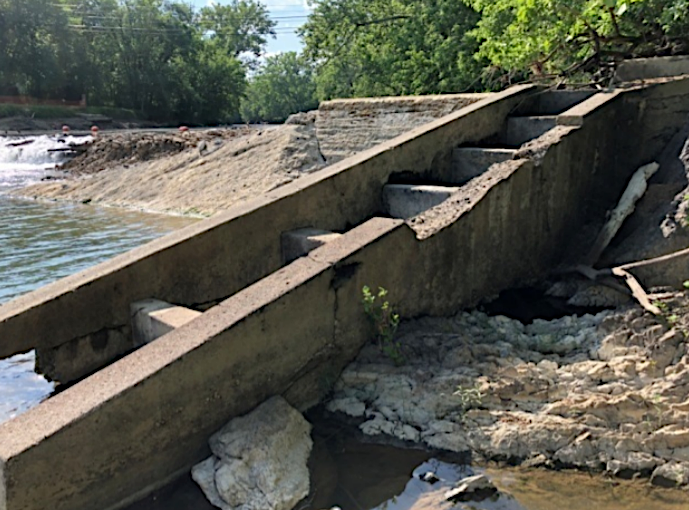
the 1911 fish ladder was not functional; the Jordan's Point Dam blocked fish passage
Source: Virginia Department of Game and Inland Fisheries, Removal Report on Jordan's Point Concrete Dam and Timber Crib Dam: May 23-25, and May 28-30, 2019
The city's costs would be just $20,000 for in-kind services, plus $8,000 for plants to restore the vegetation along the shoreline. Traditionally the city had budgeted $25,000 annually for maintaining the dam and Jordan's Point Park.
The Jordan's Point Dam was historic and created a flatwater pool that could be used for recreational use, but the City Manager thought removal vs. preservation was an easy choice:3
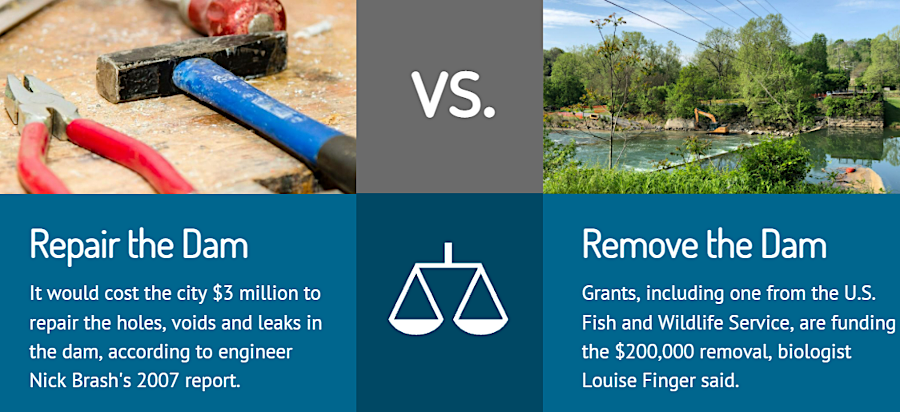
Lexington's share of the cost for dam removal was far lower than the alternative of repairing the historic structure to meet modern dam safety requirements
Source: Demolishing the Dam, Remove or Repair
The Virginia Department of Game and Inland Fisheries completed an Environmental Assessment that considered six alternatives. The decision to remove the dam included a commitment to preserve some of the historical character of the dam, which was built before 1900.
The final alternative selected in 2018 was to breach the dam in the middle, but retain portions on either side of the river and the defunct fish ladder to interpret the past. The project included taking out eight piers of an abandoned railroad bridge downstream of the dam that were located in the active river channel (leaving five other piers).4
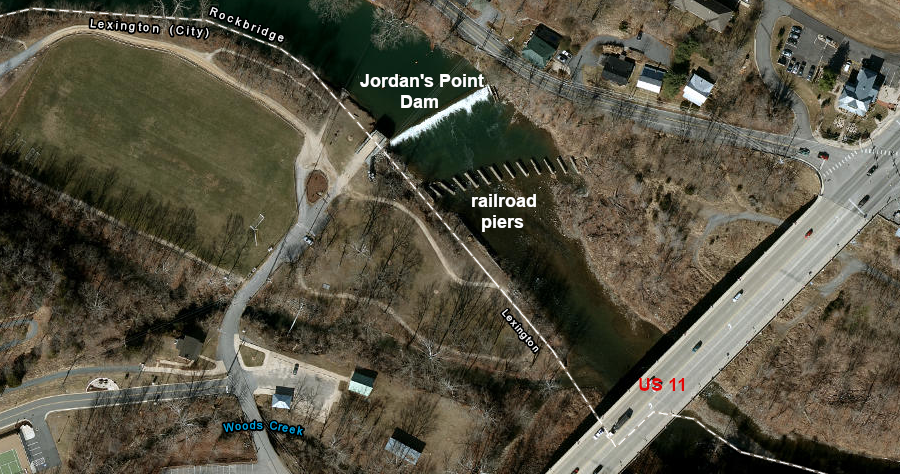
Jordan's Point Dam (and piers downstream from abandoned railroad bridge)
Source: ESRI, ArcGIS Online
A non-profit group formed by "dam fans, pro-dam owners and operators of dams" made a last-minute proposal in 2018 to retain the Jordan's Point Dam. It was the first orphan dam that American Dams, Inc. offered to purchase, Another option was for Rockbridge County to assume ownership of the dam, transferring the cost of repair and responsibility for maintenance from the City of Lexington. One possibility was to reduce the water level behind the dam low enough so it was no longer required to meet the state's dam safety regulations, but it was not clear if major repair costs could be avoided by that proposal.
The Virginia Military Institute (VMI) also urged preservation rather than removal of the dam. Keeping the dam in place would retain the flatwater pool next to VMI's campus, which was used for cadet training. Retaining the dam would also prevent instream and riparian disturbances associated with dam removal. Placing stone in the riverbed below dam was proposed as a way to reduce the drowning hazard.
One advocate for dam removal stated:5
The city was obligated to make a decision by August 1, 2018, and to repay the Virginia Department of Game and Inland Fisheries $60,000 in planning costs if it withdrew from the removal agreement.
However, Lexington officials decided that the proposal was not sufficiently complete to justify breaking the deal negotiated with state and Federal officials. On July 28, 2018, City Council voted for a second time to remove the dam. The two members on City Council who worked at VMI had to recuse themselves from the vote, since their employer had taken a public position on the issue.
First, two historic millstones were extracted from the river in April, 2019. They were saved for use in interpretive exhibits; one is now on display at the Miller's House, which had been constructed in 1811. The millstones are thought to have been quarried and carved at the Brush Mountain Millstone Quarry in Montgomery County.
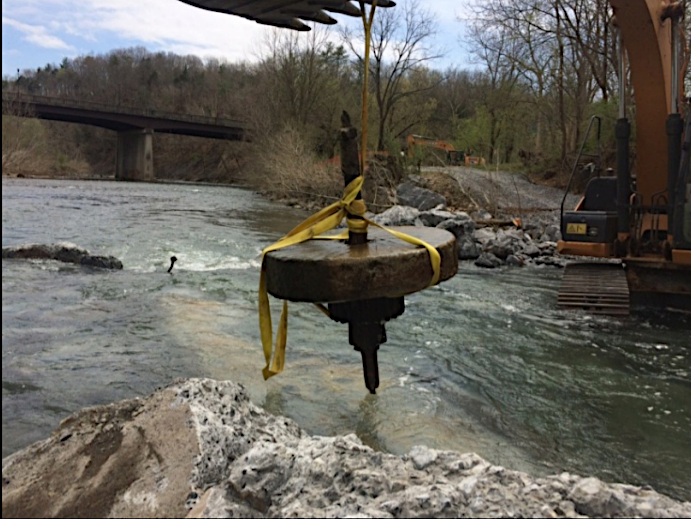
two millstones were removed from the Maury River near Jordan's Point Dam
Source: Virginia Department of Game and Inland Fisheries, Removal Report on Jordan's Point Concrete Dam and Timber Crib Dam: May 23-25, and May 28-30, 2019
Also in April, eight of the thirteen piers from the former railroad bridge downstream of the dam were removed. The Jordan's Point Dam was removed in late May, 2019. That beat the deadline; the state's operation and maintenance certificate for the dam expired on November 3.
Workers cut into the concrete dam, and also removed the center of the old wood and stone crib dam. A complete "crib" of round logs was removed in pieces and stored until an interpretive exhibit could be created.
A 13-foot section of the concrete dam was kept intact on the south bank of the river, and attached to it were remnants of the 1840 wood and stone crib dam. On the northern bank, a 16-foot section plus the old fish ladder were retained for future interpretation of historical development at the site.6
The Maury River water level dropped five feet at Jordan's Point after the dam was removed. Fish could easily swim upstream to the headwaters of the Maury River at Goshen Pass, and onward into the Calfpasture and Little Calfpasture rivers.
Because the loss of the dam impacted the Jordan's Point Historic District, the dam and its removal were thoroughly documented as partial mitigation for the loss. City officials planned to retain the "natural feel" of the park, while increasing public access to the river for recreational use.7
Later erosion of the sediments that had accumulated behind the dam exposed more timbers from the 1806 dam or a later replacement, the diversion dam upstream of it, plus the remains of a wooden ferry used to cross the river.8
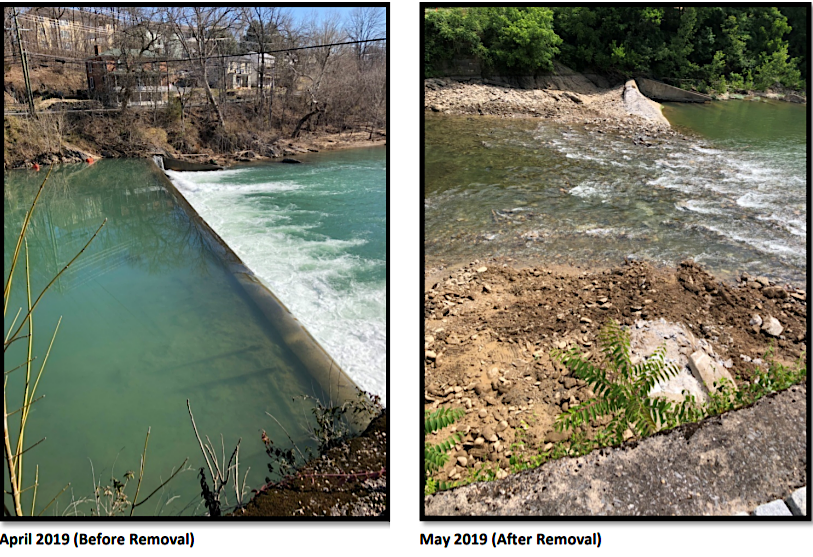
removing Jordan's Point Dam converted a flatwater reservoir into a free-flowing river
Source: Virginia Department of Game and Inland Fisheries, Removal Report on Jordan's Point Concrete Dam and Timber Crib Dam: May 23-25, and May 28-30, 2019
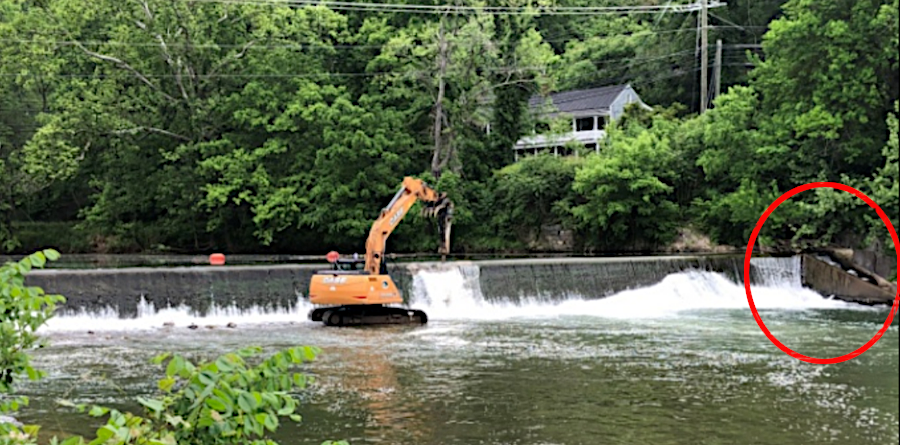
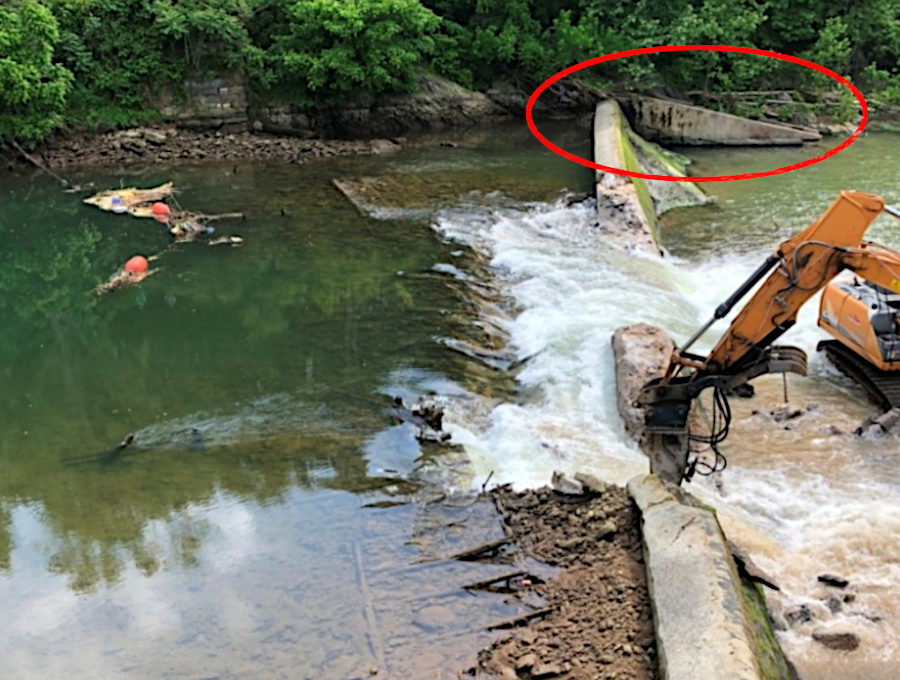
removal of Jordan's Point Dam started by cutting through the concrete cap in the middle of the river (fish ladder on north bank is circled in red)
Source: Virginia Department of Game and Inland Fisheries, Removal Report on Jordan's Point Concrete Dam and Timber Crib Dam: May 23-25, and May 28-30, 2019
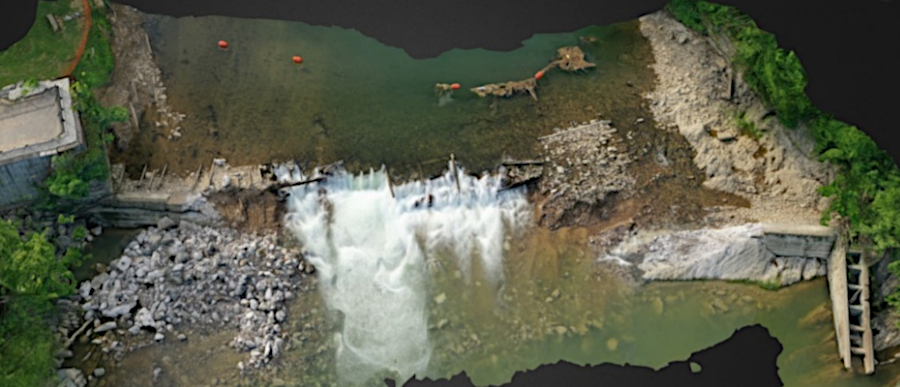
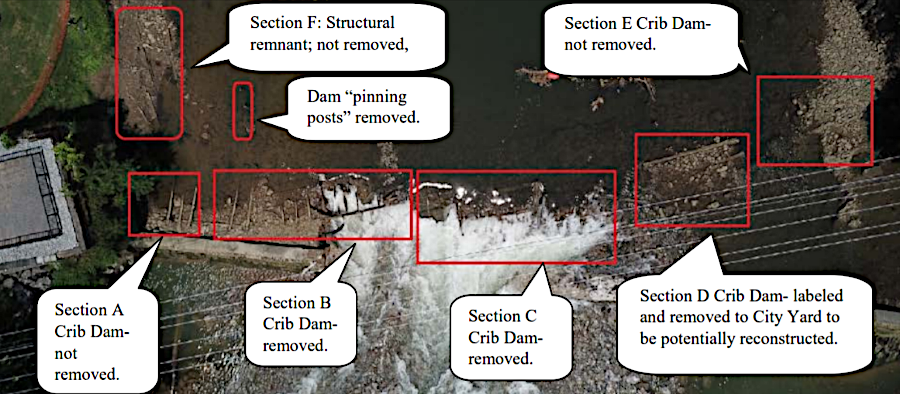
removal of Jordan's Point Dam was thoroughly documented as partial mitigation for alteration of the historic site
Source: Virginia Department of Game and Inland Fisheries, Removal Report on Jordan's Point Concrete Dam and Timber Crib Dam: May 23-25, and May 28-30, 2019